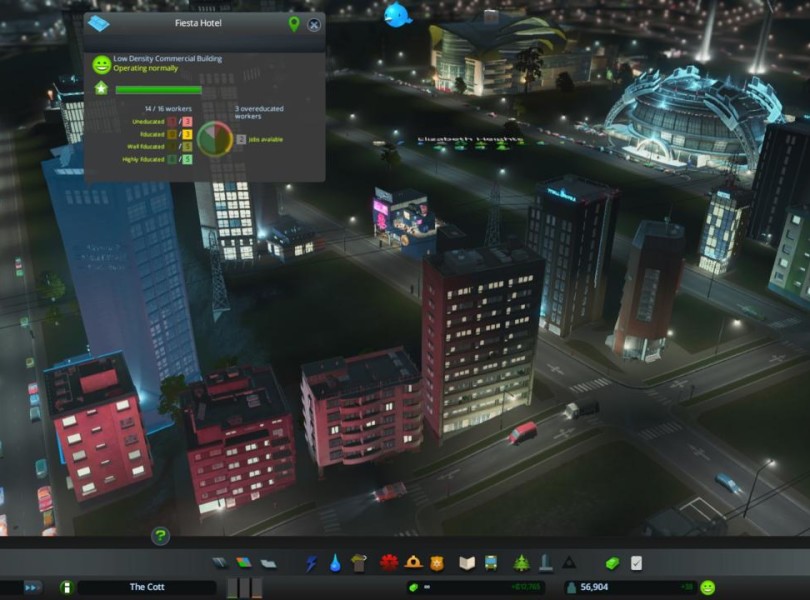As the old song says, “At night, it’s a different world.” That old Lovin’ Spoonful lyric holds true in After Dark, the first expansion for Colossal Order’s Cities: Skylines. After Dark adds a day-night cycle to the Cities experience, expanding the realism of the original game by giving you a glimpse into what city life is like after the sun goes down. The experience is further boosted with more subtle gameplay tweaks, including new commercial districts for leisure and tourism, extended budgetary demands–keeping those streetlights on isn’t free–and a number of new buildings and policies. Even though this add-on only subtly adjusts the focus of the original game, it broadens the scope in such a way that I have to recommend it as an essential purchase for any and all virtual mayors.
My review of Cities: Skylines played up my real-world role as the mayor of a Canadian town, and I have to fall back on that again to reiterate just how much this game captures the experience of leading an actual municipality. Even with real-world irate midnight calls from residents (fortunately) removed from the picture in Cities: Skyline, the original was a thorough simulation of what it takes to build and run a city, complete with proper zoning for residential, commercial, and industrial development. It included policies that let you set something of a big picture for your administration, as well as lots of little touches like being able to name and create boroughs with distinct identities. Sure, it was a little bit on the dry side, especially with no fanciful SimCity concepts like giant monster attacks and superheroes. But it worked, and it was so true to life that it still draws me in for occasional sessions of pretending to be a mayor, when I generally like playing games specifically to forget that I actually am one.

After Dark doubles down on all of the above. As the name indicates, the hook for this expansion is the addition of a full day-night cycle. While the original’s in-game time was stuck pretty much at high noon, the sun now goes up and down just like it does in the real world. This reveals a beautiful skyline with lights sparkling from building windows and new nighttime accoutrements such as neon signs and video screens. The one drawback is that night is a bit too black, obscuring fine terrain details that you need to see while dropping down roads, pipes, and electrical lines. I plowed power lines right through a row of buildings on a couple of occasions, so you have to be careful at night here.
The most noteworthy new option the expansion brings is the ability to designate commercial zones as specialized leisure and tourism districts, just as you could mark off industrial districts for specific purposes in the original game. The leisure sector ties into the “sun going down” theme of the expansion by allowing you to establish what amounts to entertainment districts where your citizens can dance all night, go to movies, torture the lyrics of old songs in karaoke bars, work out in all-night gyms, and so on. Tourism lets you create tourist traps that soon wind up dotted with attractions like hotels, seaside restaurants on piers, marinas, and docks for fishing tours, along with bigger unique amenities such as a zoo and a casino that are unlocked after dedicating fairly large city sections to this new industry.
Overnight considerations must be taken into account across the city now, most notably when it comes to after-hours expenses. The budget screen is now split into day and night with separate sliders, so you can do things such as crank up the police budget to deal with the added crime that comes after sunset. Nothing here requires more than minor adjustments in city planning, however. Plop down a cop shop in the new districts, tweak the sliders a bit, and you’re covered.
Cities: Skylines is now a much more well-rounded depiction of city life in comparison with the original game, which in retrospect is more of a 9-to-5 business simulation.
The whole concept for life after dark is a little buttoned-down, so don’t expect any wild red-light districts to grow up in the midst of your predictable old cities. Cities here are still the same well-mannered, easy-to-govern burgs that they were when the game first launched in the spring. The staid nature of everything fits in perfectly with the orderly towns created here. This is an authentic view of what happens in a typical low-crime city when the sun goes down, not a GTA-style caricature of hookers and guns.
Other changes are slighter. New buildings have been added to the core stock, including the aforementioned zoo and a prison for all the criminals generated by the new night life. New roads can be laid down that split into separate lanes for vehicles and bikes. This seems to be nothing more than a cosmetic change, however. Nothing seems to have been done to ease the transit confusion that I observed in the original game, which is a little disappointing, though I continue to stumble through when it comes to buses and subways.
Nothing here dramatically alters gameplay. The city at night functions much the same as the city during the day, with a dash of extra crime and cops. And taxis, which, after you build the initial depot, seem to flood the streets in the late hours to ferry people around new attractions–a great idea for the leisure and tourism districts to speed up transportation in the wee hours. There is also no revamped learning curve. I sat down with the expansion and had districts for both new specialties humming within a half-hour or so, with hotels, souvenir shops, and arcades popping up all over the place.

Still, I really appreciate the nighttime focus and the way that entertainment and tourism are now treated as serious economic drivers alongside industry and commercial stores. All of this adds an appreciable new dimension to the original game. Cities: Skylines is now a much more well-rounded depiction of city life in comparison with the original game, which in retrospect is more of a 9-to-5 business simulation. This change dramatically expands the realism of the entire game. It also places added demands on me as the mayor, as I now have to look after my residents when it comes to leisure hours after work and take care of visitors who drop by to hang out in our restaurants and hotels.
Finally, a handful of new policies are introduced. They broaden the options only slightly, though, through things like making leisure districts tax-free to make them more attractive and banning bicycles from all but dedicated bicycle lanes.
After Dark may not be a revolutionary addition to Cities: Skylines, but the number of impressive new features and enhancements offered here is more than good enough to get my vote again. Both the new day-night cycle and the leisure and tourism districts add new scope and breadth to city life, especially when the sun goes down. These elements, plus all the other extras, make for a grand and worthwhile expansion. Wannabe virtual mayors can feel free to sign on to another term with the city-building incumbent.


